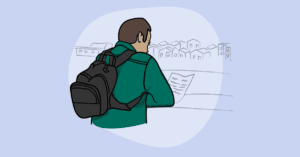- News and Stories
- Blog post
- Principles & Practices
Government Gains with Philadelphia

In our Government Gains series, we’re talking to dedicated public servants to learn three things about a recent project they’ve worked on that shows what’s possible when people ideate, collaborate, and innovate within government. At Code for America, we welcome a variety of viewpoints—and we strive to let people express themselves in their own words about their unique experiences. With that in mind, the following has received only minor edits for length and clarity, and the views expressed here reflect those of the author.
For this installment, we spoke with Nicola Coakley, the Research and Policy Manager for the Managing Director’s Office in the City of Philadelphia. Her team is working on the city’s Zero Fare program, which has helped over 35,000 residents with low income access public transit for no cost. In their extended pilot phase, her team is evaluating the impact of giving participants unlimited transit passes, and how this program has improved access to jobs and essential services while reducing household costs. We spoke with her about what made this project challenging—and rewarding.
What was the biggest challenge you faced in this project?
When we were rolling out Zero Fare, we wanted to make it as accessible as possible and prioritize equitable and expansive reach. The program was initially funded as a two-year pilot, so we also wanted to get the transit cards in people’s hands quickly to maximize the time they had the benefit.
Most social safety net programs use an application-based model where residents need to find out about the program, figure out their eligibility, and then submit an application. But that causes administrative burdens—both on the people who need to apply and gather all the documents to verify their eligibility, and on the practitioners who spend a lot of time processing those applications. This creates inequities in access because the model favors people with the time, resources, and information needed to apply. Certain groups of people are systematically missed.
Zero Fare is designed to reduce barriers to access by using automatic enrollment. We created a list of residents who met the program’s eligibility criteria, and then did lottery selection from there to enroll participants. Importantly, for this model of auto-enrollment to work, you need high-quality administrative data and processes in place to access and use that data for this purpose. Zero Fare benefits from decades of work at the city level to track people’s touchpoints and integrate person-level data gathered across departments; none of this would be possible without the Office of Integrated Data for Evidence and Action (IDEA), which operates the City’s cross-systems data hub.
But even with that good data and automatic enrollment, we still need to reach people in order for the model to work. We need to contact participants about their selection, build trust that the program is real and not a scam, and then get physical cards in their hands. That’s been a challenge.
How did you approach this challenge, and how did you decide which tools to use to solve it?
Prior to launching, we did a series of focus groups with eligible residents to figure out how we should message about auto-enrollment, given that this is not a commonly used practice. We also weren’t sure how much we should advertise publicly about a program that people generally couldn’t apply for. About 90% of the program is auto-enrolled, and the other 10% of the spots were reserved for enrollment through community-based partners serving eligible residents who would not appear on the list used for auto-enrollment.
Those conversations helped inform our outreach process. Once we select the program’s participants, but before they receive the fare card, we do phone and text outreach to make people aware of the program and that they’ve been selected and to verify their mailing address. We learned so much about the mailing process and how much work goes into address verification.
Over the course of rollout, we ran a digital and print media campaign to provide information about the program on buses, trains, bus shelters, and in convenience stores and other locations. Then, when we saw that some geographies in the city had slightly lower uptake than other areas, we decided to launch a tailored digital media campaign targeted to the ZIP codes with the highest rates of non-usage. That was an iterative decision made down the line—we wanted to be responsive to what we were seeing in the data and get more public information about the program in front of people who might have missed our outreach or been skeptical of the program.
There’s so much opportunity to streamline people’s access to the programs and services they qualify for, and we’re demonstrating that there’s a viable model to use existing data infrastructure to get a benefit in someone’s hand.
Where will the lessons you learned here be applied in the future?
We’ve learned a lot about the practicalities of implementing this type of enrollment model and what needs to be in place to make it successful. Some of those lessons were applied in real time, like with our targeted outreach and media campaign, but we also hope the lessons here inspire future policy decisions in Philadelphia and elsewhere. There’s so much opportunity to streamline people’s access to the programs and services they qualify for, and we’re demonstrating that there’s a viable model to use existing data infrastructure to get a benefit in someone’s hand. This model may not be the best way to reach every eligible person—and it’s important to be mindful of that—but it’s a very effective way to reduce administrative burdens and reach a lot of eligible people at scale.
Nicola presented about the Zero Fare program at FormFest 2025. Check out her session and all other FormFest content on our YouTube channel.